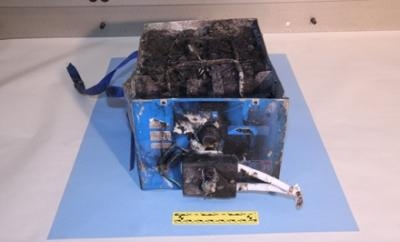Fri, Jan 18, 2013
Two Recent Incidents Now Appear Different In Nature
Quoting sources that would speak only on the condition of anonymity, the Seattle Times is reporting that hot chemicals sprayed out of the battery on the 787 Dreamliner that made an emergency landing in Japan on Wednesday. The result was a gooey dark residue left behind that suggests a different malfunction than last week's battery fire in a 787 at Boston's Logan International Airport.

While there was no fire in the most recent incident one of the Times' sources said "It's still a problem. There was significant overheating."
The more significant problem may become the emerging reports that Boeing was warned about the safety of the batteries and associated systems as early as 2006. Those reports center on the actions of whistleblower Michael Leon.
Aviation reporter and blogger Ben Sandilands writes in Plane Talking that while employed at Securaplane, which brought together mission critical battery assemblies for the 787, Leon wrote a report on the battery technology planned for the 787 saying it was a flight of safety risk and that substitute battery technology should be used. A month later, Securaplane's main buildings were burned to the ground when a battery test went wrong. Leon was injured in the blaze. Securaplane reportedly tried to force Leon out of the company when he refused to ship what he considered an unsafe battery assembly to Boeing for use in the 787. That assembly later malfunctioned when installed in a prototype airframe.
There are four circuits that control the batteries in question, two within the battery and two external. Boeing says it believes those circuits performed as designed and stopped the overheating before any fire could start. Additionally Boeing says tests show that any smoke from the incident should have vented overboard through outflow valves and not entered either the passenger cabin or cockpit. But ANA (All Nippon Airways) said its pilots did smell something they thought was smoke and that the smell was also in the passenger cabin. The FAA, in announcing its decision to ground the fleet said in its statement that both battery incidents resulted in the "release of flammable electrolytes, heat damage, and smoke."

It was that smell and warnings of battery trouble on the instrument panel that compelled the ANA pilot to execute the emergency landing and deploy the emergency exit chutes to evacuate the 137 passengers and crew.
The Times reports that two people with knowledge of the incident said the pilot received three battery warnings, including one that said the battery was overheating.
The 787s batteries are made by GS Yuasa of Japan and its manufacturing process is almost certainly gong to become part of the investigation.
(Images provided by the NTSB)
More News
“These new aircraft strengthen our ability to respond quickly, train effectively and support communities nationwide. Textron Aviation has been a steadfast supporter in helpin>[...]
From 2011 (YouTube Edition): Rugged, Legendary, STOL Twin Makes A Comeback The de Havilland Twin Otter is an airplane with a long history, and it gained a reputation as a workhorse>[...]
A Wind Gust Lifted The Right Wing And The Airplane Turned To The Left Analysis: The pilot was departing from a 2,395-ft-long by 50-ft-wide turf runway. The pilot reported that afte>[...]
Have A Story That NEEDS To Be Featured On Aero-News? Here’s How To Submit A Story To Our Team Some of the greatest new stories ANN has ever covered have been submitted by our>[...]
Braking Action Advisories When tower controllers receive runway braking action reports which include the terms “medium," “poor," or “nil," or whenever weather con>[...]
 Aero-News: Quote of the Day (12.18.25)
Aero-News: Quote of the Day (12.18.25) Classic Aero-TV: Viking Twin Otter 400--Bringing the DHC-6 Back Into Production
Classic Aero-TV: Viking Twin Otter 400--Bringing the DHC-6 Back Into Production NTSB Final Report: Rans Employee Flying Club Rans S-6ES Coyote II
NTSB Final Report: Rans Employee Flying Club Rans S-6ES Coyote II ANN FAQ: Submit a News Story!
ANN FAQ: Submit a News Story! ANN's Daily Aero-Term (12.18.25): Braking Action Advisories
ANN's Daily Aero-Term (12.18.25): Braking Action Advisories




